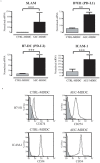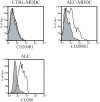Airway epithelial cells condition dendritic cells to express multiple immune surveillance genes
- PMID: 22984588
- PMCID: PMC3439377
- DOI: 10.1371/journal.pone.0044941
Airway epithelial cells condition dendritic cells to express multiple immune surveillance genes
Abstract
Increasing evidence suggests that crosstalk between airway epithelial cells (AEC) and adjacent dendritic cells (DC) tightly regulates airway mucosal DC function in steady state. AEC are known to express multiple immuno-modulatory factors, though detailed information on how this influences human DC function remains incomplete. We recently demonstrated using an in vitro coculture model that AEC alter differentiation of monocytes into DC in a manner that inhibits expression of potentially damaging Th2 effector function. In the current study, we have extended these findings to examine other aspects of DC function. Using micro-array technology we show that multiple genes important for immune surveillance are significantly over expressed in purified AEC-conditioned DC, compared to control DC. These findings were confirmed by quantitative real time PCR or flow cytometry in an independent sample set. In particular, AEC-conditioned DC showed selective upregulation of chemokines that recruit Th1 cells, but minimal change in chemokines linked to Th2 cell recruitment. AEC-conditioned DC were also characterized by enhanced expression of complement family genes (C1QB, C2, CD59 and SERPING1), Fcγ receptor genes (FCGR1A, FCGR2A, FCGR2B and FCGR2C), signaling lymphocytic activation molecule family member 1 (SLAM), programmed death ligands 1 and 2, CD54 and CD200R1, relative to control DC. These findings suggest that AEC conditioning facilitates the capacity of DC to react to danger signals, to enhance leukocyte recruitment, especially of Th1 effector cells, and to interact with other immune cell populations while minimizing the risks of excessive inflammation leading to tissue damage.
Conflict of interest statement
Figures





Similar articles
-
Airway epithelial cells regulate the functional phenotype of locally differentiating dendritic cells: implications for the pathogenesis of infectious and allergic airway disease.J Immunol. 2009 Jan 1;182(1):72-83. doi: 10.4049/jimmunol.182.1.72. J Immunol. 2009. PMID: 19109137
-
Differential expression of inflammatory chemokines by Th1- and Th2-cell promoting dendritic cells: a role for different mature dendritic cell populations in attracting appropriate effector cells to peripheral sites of inflammation.Immunol Cell Biol. 2005 Oct;83(5):525-35. doi: 10.1111/j.1440-1711.2005.01365.x. Immunol Cell Biol. 2005. PMID: 16174103
-
IL-4 blocks TH1-polarizing/inflammatory cytokine gene expression during monocyte-derived dendritic cell differentiation through histone hypoacetylation.J Allergy Clin Immunol. 2013 Dec;132(6):1409-19. doi: 10.1016/j.jaci.2013.08.039. Epub 2013 Oct 17. J Allergy Clin Immunol. 2013. PMID: 24139608
-
Interactions between airway epithelial cells and dendritic cells: implications for the regulation of airway inflammation.Curr Drug Targets. 2006 May;7(5):541-5. doi: 10.2174/138945006776818647. Curr Drug Targets. 2006. PMID: 16719765 Review.
-
Estrogen receptors regulate an inflammatory pathway of dendritic cell differentiation: mechanisms and implications for immunity.Horm Behav. 2012 Aug;62(3):254-62. doi: 10.1016/j.yhbeh.2012.04.011. Epub 2012 Apr 25. Horm Behav. 2012. PMID: 22561458 Free PMC article. Review.
Cited by
-
Direct contact between dendritic cells and bronchial epithelial cells inhibits T cell recall responses towards mite and pollen allergen extracts in vitro.Clin Exp Immunol. 2015 Aug;181(2):207-18. doi: 10.1111/cei.12611. Epub 2015 Jun 11. Clin Exp Immunol. 2015. PMID: 25707463 Free PMC article.
-
Dendritic Cell-Airway Epithelial Cell Cross-Talk Changes with Age and Contributes to Chronic Lung Inflammatory Diseases in the Elderly.Int J Mol Sci. 2017 Jun 6;18(6):1206. doi: 10.3390/ijms18061206. Int J Mol Sci. 2017. PMID: 28587289 Free PMC article. Review.
-
Immune checkpoint molecules in prevention and development of asthma.Front Immunol. 2023 Feb 14;14:1070779. doi: 10.3389/fimmu.2023.1070779. eCollection 2023. Front Immunol. 2023. PMID: 36865540 Free PMC article. Review.
-
Unraveling the Role of Epithelial Cells in the Development of Chronic Rhinosinusitis.Int J Mol Sci. 2023 Sep 18;24(18):14229. doi: 10.3390/ijms241814229. Int J Mol Sci. 2023. PMID: 37762530 Free PMC article. Review.
-
Harnessing the potential of the NALT and BALT as targets for immunomodulation using engineering strategies to enhance mucosal uptake.Front Immunol. 2024 Sep 2;15:1419527. doi: 10.3389/fimmu.2024.1419527. eCollection 2024. Front Immunol. 2024. PMID: 39286244 Free PMC article. Review.
References
-
- Holt PG, Upham JW (2004) The role of dendritic cells in asthma. Curr Opin Allergy Clin Immunol 4: 39–44. - PubMed
-
- Landsman L, Varol C, Jung S (2007) Distinct differentiation potential of blood monocyte subsets in the lung. J Immunol 178: 2000–2007. - PubMed
-
- Upham JW, Denburg JA, O'Byrne PM (2002) Rapid response of circulating myeloid dendritic cells to inhaled allergen in asthmatic subjects. Clin Exp Allergy 32: 818–823. - PubMed
Publication types
MeSH terms
Substances
Associated data
- Actions
LinkOut - more resources
Full Text Sources
Medical
Molecular Biology Databases
Miscellaneous

